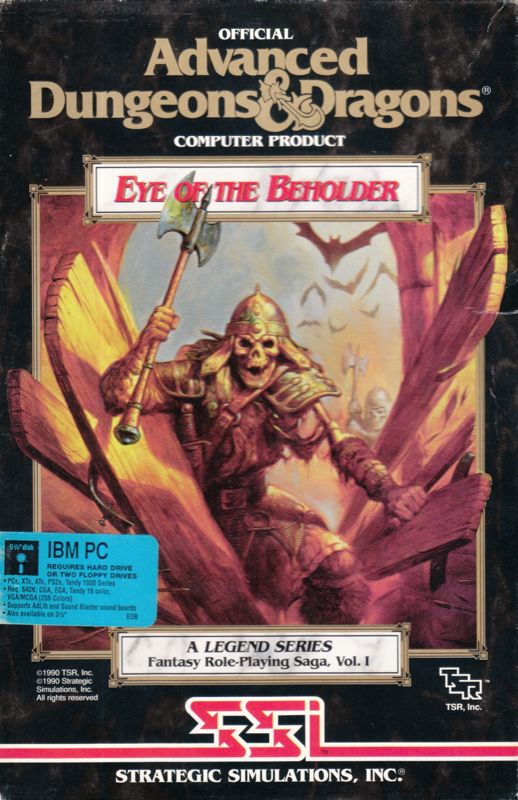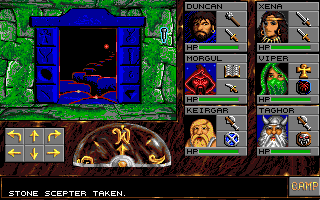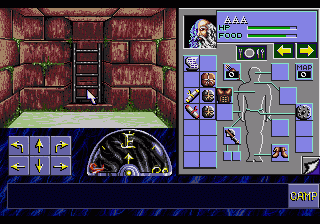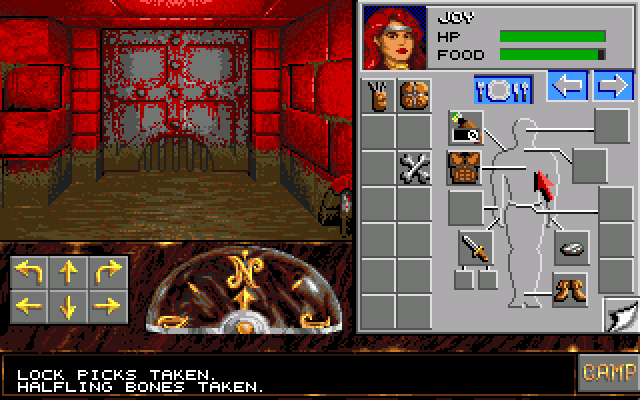Retro Replay Review
Gameplay
Eye of the Beholder plunges you directly into the gritty tunnels beneath Waterdeep, tasking a party of four adventurers—and up to two later allies—with facing monsters, traps, and puzzles in real time. The interface is point-and-click throughout: you move your party, draw weapons, cast spells and interact with the environment using intuitive mouse controls. This hands-on approach keeps the pace brisk, demanding quick thinking when monsters appear from dark corners or pressure plates trigger deadly traps.
(HEY YOU!! We hope you enjoy! We try not to run ads. So basically, this is a very expensive hobby running this site. Please consider joining us for updates, forums, and more. Network w/ us to make some cash or friends while retro gaming, and you can win some free retro games for posting. Okay, carry on 👍)
The combat system borrows heavily from the 2nd Edition AD&D rules, translating turn-based mechanics into a dynamic, real-time experience. Spells must be selected and cast on the fly, healing potions popped during battle, and positioning becomes crucial as enemies swarm. The tension of real-time encounters is heightened by limited inventory space and the ever-present risk of party members falling in the narrow corridors.
Puzzles and environmental hazards are woven seamlessly into the dungeon layout, forcing players to explore every nook of the twisting passageways. Hidden doors, pressure plates, and elusive switch mechanisms encourage careful mapping and note-taking. The game rewards curiosity with secret treasures and shortcuts, while also punishing hasty progress through relentless ambushes.
Progression feels rewarding: your heroes gain experience, loot, and new spells as you delve deeper, while the difficulty curve steadily ramps up. Later levels introduce more complex multi-stage traps and tougher foes, ensuring that you must continually adapt tactics, balance your spell slots, and manage healing resources lest you be overwhelmed below the city streets.
Graphics
For its time, Eye of the Beholder’s graphics deliver an immersive sense of claustrophobic dungeon crawling. The game’s first-person perspective uses richly detailed, hand-drawn 2D corridors that change seamlessly as you turn corners and navigate staircases. Though limited to a modest color palette, the textures of damp stone walls and flickering torchlight create a believable subterranean atmosphere.
Monster sprites are distinct and instantly recognizable—skeletal warriors, oozing slimes, giant spiders and the infamous beholder all leap out of the darkness with fluid animations. Combat animations are satisfying, with swords swinging, spells flaring and creatures collapsing in a shower of pixelated gore. The occasional sprite flicker or palette swap is a small price to pay for the lively action on screen.
UI elements are cleanly integrated at the bottom of the screen, showing party portraits, hit points, spell slots and inventory icons without obscuring critical sightlines. The point-and-click cursors change contextually, signaling where you can attack, open doors or examine objects, which keeps the focus on exploration rather than menu-wrestling.
Overall, the game’s visual presentation remains charmingly retro yet surprisingly functional. Even modern players will appreciate the clear level layouts and distinct visual cues that guide you through each new chamber, making mapping and orientation straightforward in a game that thrives on labyrinthine design.
Story
The narrative hook is classic dungeon-crawler fare: something evil stirs beneath the city of Waterdeep, and the Lords of Waterdeep have summoned a band of heroes to root out the threat. From the moment your party enters the sewers and the ceiling collapses behind you, you understand that escape is impossible and that the depths hold more than just rats and filth.
As you descend level by level, notes, journals and cryptic messages hint at a darker plot orchestrated by an unseen observer. These story fragments provide context for the various denizens you face and gradually reveal the sinister purpose behind the dungeon’s design. While the narrative is linear, the atmosphere of creeping dread and constant surveillance keeps you invested in uncovering the truth.
Character interactions are concise but effective: NPCs you recruit later bring unique perspectives and motivations, and overheard dialogue often hints at moral choices you might face. Though dialogue options are limited compared to modern RPGs, the stakes feel personal when you realize that your decisions determine whether your allies live or die in the unforgiving corridors.
Eye of the Beholder doesn’t rely on grand plot twists or sprawling epics; instead, it excels at maintaining tension in a confined, monster-haunted environment. The story’s strength lies in its measured revelations and the growing sense that something monstrous is watching your every move.
Overall Experience
Eye of the Beholder stands as a prime example of early 1990s dungeon-crawling ingenuity, blending real-time AD&D mechanics with atmospheric level design. The learning curve can be steep for newcomers unfamiliar with party management or classic RPG conventions, but veterans will appreciate the faithfulness to tabletop roots.
The balance of combat, exploration and puzzle-solving ensures that no two sessions feel the same. A sudden ambush in a narrow hallway or a cleverly hidden secret door can save—or doom—your party, making every decision feel weighty. Replay value is high, as experimenting with different party compositions and tactics yields fresh challenges.
Minor rough edges—such as inventory micromanagement and the occasional dead-end requiring backtracking—are offset by the game’s immersive atmosphere and rewarding progression. Sound effects and a moody soundtrack heighten the tension, while the tight controls keep the experience flowing smoothly.
For those seeking a challenging, old-school RPG that emphasizes exploration and resource management, Eye of the Beholder remains a must-play. Its combination of real-time combat, atmospheric graphics and engaging dungeon design offers a timeless journey into the depths beneath Waterdeep.
 Retro Replay Retro Replay gaming reviews, news, emulation, geek stuff and more!
Retro Replay Retro Replay gaming reviews, news, emulation, geek stuff and more!









Reviews
There are no reviews yet.